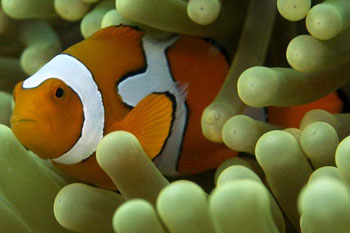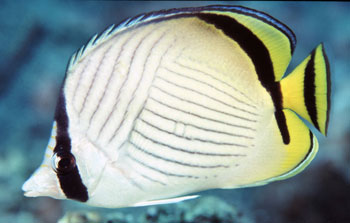Coral reef fish return home after drifting the seas
Coral reef fish return home after drifting the seas
mongabay.com
May 3, 2007
Most coral reef fish larvae return to their “home” reefs after spending weeks to months maturing in the open ocean, reports a new study published in the journal Science. The findings improve the understanding of coral reef ecosystems and have implications for marine conservation efforts.
 An adult Amphiprion percula. Image courtesy of Science and S.R. Thorrold  An adult Chaetodon vagabundus. Image courtesy of Science and R. Patzner |
Tracking two species of reef fish with markedly different reproduction habits, an international team of researchers led by Glenn R. Almany of James Cook University in Australia, found that larvae usually return to the reef where they were born after extended periods at sea. The scientists say the results may help improve coral reef conservation.
“If natal homing of larvae is a common life-history strategy, the appropriate spatial scales for the management and conservation of coral reefs are likely to be much smaller than previously assumed,” the authors write. “However, if natal homing and larval retention are common, some [marine protected areas] may fail to deliver substantial recruitment subsidies to locations beyond their boundaries. We therefore support recent suggestions that [marine protected area] networks should be combined with conventional management strategies to both protect threatened species and ensure the sustainability of fisheries on coral reefs.”
The study was conducted in Kimbe Bay, Papua New Guinea, using the Orange clownfish (Amphiprion percula) and the vagabond butterflyfish (Chaetodon vagabundus). The researchers did not say how the larvae find their way home after development.
CITATION: Glenn R. Almany, Michael L. Berumen, Simon R. Thorrold, Serge Planes, and Geoffrey P. Jones (2007). Local Replenishment of Coral Reef Fish Populations in a Marine Reserve. Science, May 4, 2007.







